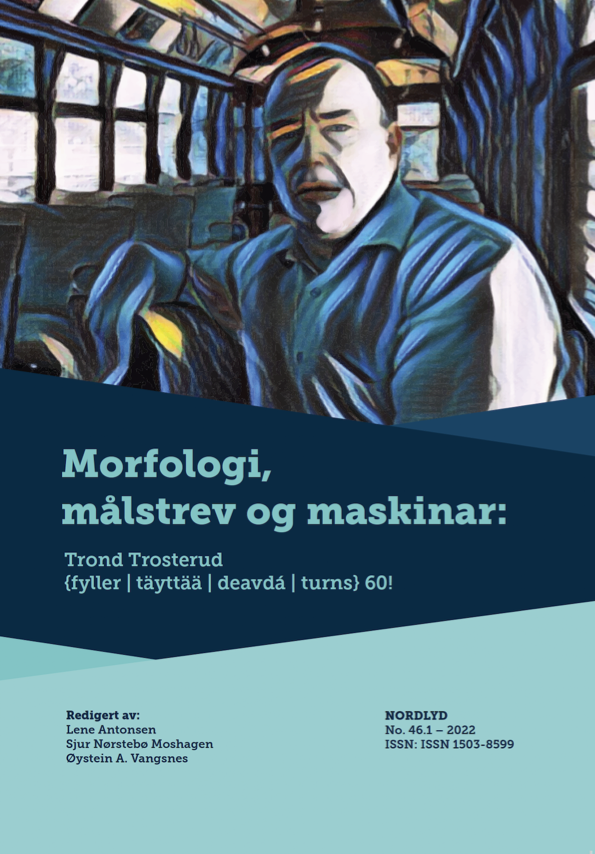Mo, do, so, da – duortnussámi dovdomearkan?
DOI:
https://doi.org/10.7557/12.6394Keywords:
North Saami, Torne Saami, dialects, language changeAbstract
In this article, I examine the dialect forms of a set of North Saami pronouns – mo, do, so, da (‘I, you, he/she, it’; standardized forms: mon, don, son, dan). More specifically, I investigate where the forms are in use and how the forms have developed. The material shows that the final -n has changed in a number of stages before it disappeared completely. I suggest that these pronominal forms are a dialect mark of the Torne Saami dialect group (named after the Torne river valley on the border between Sweden and Finland). The pronominal forms are used throughout this dialect area, and the use continues north to Kvænangen in Norway, which in turn belongs to the Sea Sami dialect group. In the Kvænangen dialect there are also a couple of other characteristics that are typical for some of the Torne Saami dialects.
References
Aikio, Ante, Laura Arola ja Niina Kunnas: Variation in North Saami. – Smakman, D. & Heinrich, P: Globalising Sociolinguistics: Challenging and Expanding Theory
Antonsen, Lene. 2007. Giella buolvvas bulvii. Gáivuona sámegiela morfologiija guorahallan. Sámegiela váldofágadutkamuš. UiT Romssa universitehta. Tilgjengelig: https://hdl.handle.net/10037/1210 (sist 14.11.2021).
Antonsen, Lene. 2008. Lokatiivva gehčosat Gáivuona suopmanis. [English summary: Locative suffixes in the Gáivuotna dialect.] – Sámi dieđalaš áigečála 2/2008: 3–20. Tilgjengelig: https://site.uit.no/aigecala/sda-2-2008_antonsen/ (sist 14.11.2021).
Bergsland, Knut. 1994. Sydsamisk grammatikk. [Karasjok]: Davvi Girji.
Collinder, Björn. 1949. The Lappish dialect of Jukkasjärvi. A morphological survey. (Vol. 37:3, Skrifter (Kungl. humanistiska vetenskapssamfundet i Uppsala)). Uppsala: Almqvist & Wiksell.
Eira, Inger Marie Gaup. 2003. Giella vákkis vággái. Gáivuona dialeavtta suokkardallan. Dieđut 2003/2. Guovdageaidnu: Sámi instituhtta.
Eriksen, Ardis Ronte. 2009. ”Mon val vuorrástuvam duoinna nuortasámegielain” Ufuohta ja Oarje-Romssa suopmana gullevašvuohta davvisámegillii ja julevsámegillii. UiT. https://hdl.handle.net/10037/1933
Henriksen, Marit B. 2002. Liidnavuona suopmana fonologiija. Mearrasámegiela suopmana fonologalaš guorahallan. Sámegiela váldofágadutkamuš. Tromssa universiteahtta.
Jernsletten, Nils. 2000. Davvisámi suopmanat. Dialektkompendium, samisk grunnfag. Humanistisk fakultet. UiT
Lindbach, Harald H. 2006. At faae disse Folk i et og andet forbedrede – misjonærer i Lyngen på 1700-tallet. Menneske og miljø. Årbok for Nord-Troms.
Nesheim, Asbjørn. 1962. The Lappish dialect of Ullsfjord and its relation to other Lappish dialects. Commentationes fenno-ugricae. In honorem Paavo Ravila. Mémoires de la Société Finno-Ougrienne 125. Helsinki: Suomalais-ugrilaisen seura. 333–360.
Nickel, Klaus Peter ja Pekka Sammallahti. 2011. Nordsamisk grammatikk. Karasjok: Davvi Girji.
QLES = Qvigstad, Just K. 1929: Lappiske eventyr og sagn III-IV. Oslo: Instituttet for sammenliknende kulturforskning.
Qvigstad, Just k. 1925. Die lappischen Dialekte in Norwegen: Lappische Texte aus Kalfjord und Helgöy : Reste eines ausgestorbenen Seelappendialektes. Oslo Etnografiske Museums skrifter, Bind 1 Hefte 1. Oslo.
Sammallahti, Pekka. 1998. The Saami languages. An Introduction. Karasjok: Davvi Girji. 6–25.
Spiik, Nils E. 1989. Lulesamisk grammatikk. Sameskolstyrelsen.
Svonni. 2013. Sátnegirji : davvisámegiela-ruoŧagiela, ruoŧagiela-davvisámegiela = Ordbok : nordsamisk-svensk, svensk-nordsamisk. ČálliidLágádus.
Downloads
Published
Issue
Section
License
Copyright (c) 2022 Lene Antonsen

This work is licensed under a Creative Commons Attribution-NonCommercial 4.0 International License.





